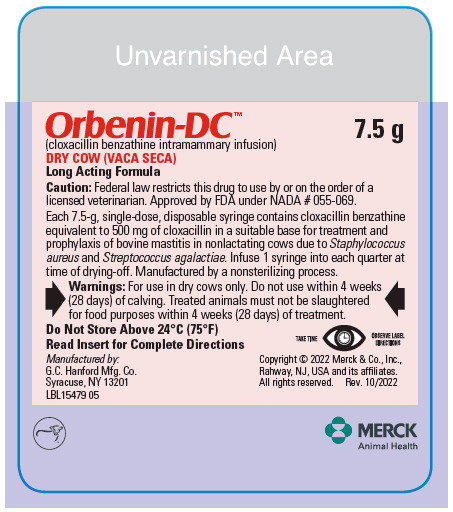FDA records indicate that there are no current recalls for this drug.
Are you a medical professional?
Trending Topics
Orbenin-dc Recall
Get an alert when a recall is issued.
Questions & Answers
Side Effects & Adverse Reactions
WARNINGS: For use in dry cows only. Do not use within 4 weeks (28 days) of calving. Treated animals must not be slaughtered for food purposes within 4 weeks (28 days) of treatment.
Legal Issues
There is currently no legal information available for this drug.
FDA Safety Alerts
There are currently no FDA safety alerts available for this drug.
Manufacturer Warnings
There is currently no manufacturer warning information available for this drug.
FDA Labeling Changes
There are currently no FDA labeling changes available for this drug.
Uses
INDICATIONS: Orbenin-DC is indicated in the treatment and prophylaxis of bovine mastitis in nonlactating cows due to Staphylococcus aureus and Streptococcus agalactiae.
History
There is currently no drug history available for this drug.
Other Information
DESCRIPTION: Orbenin-DC (benzathine cloxacillin) is a stable, nonirritating suspension of benzathine cloxacillin containing the equivalent of 500 mg of cloxacillin per disposable syringe. Orbenin-DC is manufactured by a nonsterilizing process.
Benzathine cloxacillin is a semisynthetic penicillin derived from the penicillin nucleus, 6-amino-penicillanic acid. Benzathine cloxacillin is the benzathine salt of 6-[3-(2-chlorophenyl)-5-methylisoxazolyl-4-carboxamido] penicillanic acid.
The low solubility of Orbenin-DC results in an extended period of activity. Therefore, directions for use should be followed explicitly.
Sources
Orbenin-dc Manufacturers
-
Merck Sharp & Dohme Corp.
![Orbenin-dc (Cloxacillin Benzathine) Suspension [Merck Sharp & Dohme Corp.]](/wp-content/themes/bootstrap/assets/img/loading2.gif)
Orbenin-dc | Merck Sharp & Dohme Corp.
![Orbenin-dc (Cloxacillin Benzathine) Suspension [Merck Sharp & Dohme Corp.] Orbenin-dc (Cloxacillin Benzathine) Suspension [Merck Sharp & Dohme Corp.]](/wp-content/themes/bootstrap/assets/img/loading2.gif)
DOSAGE AND ADMINISTRATION: At the last milking of lactation, milk the cow out normally. Clean and disinfect the teats with alcohol swabs provided in the carton, and infuse 1 syringe of Orbenin-DC, which has been warmed to room temperature, into each quarter. Do not milk out. The cow may be milked as usual when she calves.
The extent of subclinical and latent mastitis in a herd is frequently greater than suspected. In untreated herds a significant buildup of subclinical mastitis may occur during the dry period, which results in clinical severity after a few lactations. The adverse influence of subclinical mastitis on milk yield, the risk of cross-infection, and the chance of clinical mastitis flare-up make it necessary to treat the matter as a herd problem. Clinical studies have proven the value of treating all the cows in heavily infected herds as they are dried off. When the herd infection has been reduced, it may be desirable to be more selective in treating infected quarters.
Each carton contains 12 alcohol swabs to facilitate proper cleaning and disinfecting of the teat orifice.
Login To Your Free Account


